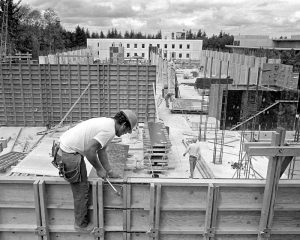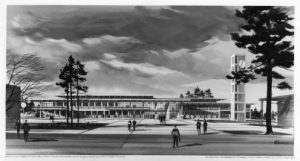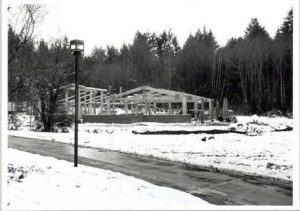None of the early universities planned for the Cooper Point area west of Olympia took hold and built a foundation like The Evergreen State College. Similar to those proposed, it too was designed to be unique and transformative. A public, Southwestern Washington institution of higher learning was a long-time goal of the state legislature that finally became a reality. Evergreen has since established its identity among post-secondary learning, and many graduates have remained to be influential in the region.

Legislative aims of starting a school in Southwest Washington sprouted early. Territorial Governor Isaac Stevens discussed the topic in his address to the new territorial legislature. “An Act to Locate the Territorial University” passed in 1855 with the legislature’s second session. Olympia was not the destination at the time since settlement populations dotted the Cowlitz valley to the south. The 1855 act stated that the new school should have two branches, one in Seattle and the other in the Boisfort Plains in Lewis County. The state continued its attempt at establishing a school and created many. However, no public, four-year school gained significant ground for the southwestern region until the 1967 legislature, and state Governor Daniel J. Evans, created Evergreen. That legislation called for the school to be in Southwest Washington, in suburban Thurston County, within a 10-mile radius of Olympia and aligned with the recommendations of the Temporary Advisory Council on Public Higher Education. State Senator Gordon Sandison, chairman of the TACPHE, expressed that the new college’s students needed to be life-long learners with the ability to continue their learning beyond graduation.
After Governor Evans signed legislation authorizing the creation of the college, the search began for gathering people to plan its implementation. The college needed a president, and Evans chose Charles McCann. McCann let the interviewing team know that he didn’t want departments, that grades didn’t make any sense to him and neither did tenure as it was. He explained that he wanted students to have experience and opportunity for individual study. In his view, two of a student’s four years would include internships and independent study.

Provost Dave Barry oversaw the academic deans in the academic planning conference in 1970, and the result was that faculty would be assigned to plan for and be part of interdisciplinary project groups. Later called coordinated studies programs, these interdisciplinary groups would consist of faculty with expertise in differing disciplines. One hope was to have a ratio of 100 students in a group matched with 5 faculty members. Students’ coordinated study would be supplemented with contracted studies, which were more specialized, inquiry-based learning, perhaps an individual or group project.
The pedagogical approach and assessment methodology planned for Evergreen was designed to be very unique. It still is today. There would be no athletic program. The curriculum would be unstructured. The new college would not use grades to evaluate student learning. Instead, they would use portfolios and evaluations written by the instructors. Credit would be issued based on accomplishment and evidence of learning rather than clocked time spent occupying a student desk.
With concepts and plans in place, the first building was constructed. The Daniel J. Evans Hall consisted of the library, faculty and staff offices, classrooms, the audio-visual department and tech support all under one roof. In February of 1971, Evergreen’s first students were admitted. “By late October, we were ready to move into our classrooms,” Ken Balsley, Thurston County Historic Commission member and 1973 Evergreen alum recalls. “Each sub-group of about 20 students and 1 faculty advisor were given a home classroom. The chairs were all wrapped in plastic and tied together with plastic zip ties. The classroom phone was still sitting in a box under the outlet, waiting to be installed. Because the chairs were all wrapped up, some of the students sat on the floor in a small circle, which became larger the more people joined. Soon we had one large circle around the whole room. Our faculty advisor initially stood in the center, before he too sat down and began the instructions. That was our normal classroom style for the whole year, even after the chairs had been unpacked.”

Photo courtesy: The Evergreen State College Archives
More additions followed. Evergreen’s first Native American studies program began in 1973, and its graduate program offering a master’s degree in public administration followed in 1979. The Tacoma branch that started in someone’s home in 1972, became official in 1983. The idea of faculty member and Lummi Tribe member Mary Ellen Hillaire was realized when the House of Welcome Longhouse Education and Culture Center opened in 1995. Seminar II followed, reflecting both teaching practices and environmental consciousness. Purce Hall was renovated, and the Center for Climate Action and Sustainability joined the campus.
The long held, legislative goal of establishing a place of higher education became reality. Greeners did fulfill Chairman Sandison’s recommendation of directing their own learning beyond college graduation. They have gone on to further their learning as well as serving the community in education, science, medicine, research, law, music, art and as entrepreneurs.


















































